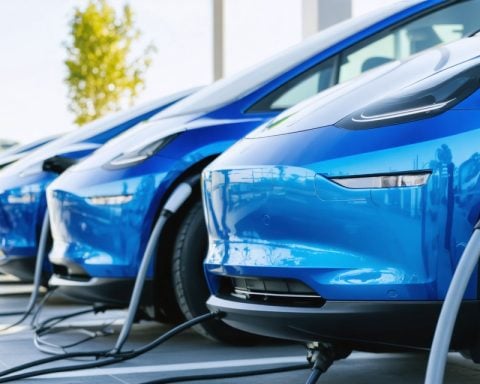- New Jersey’s electric vehicle (EV) charging expansion faces delays due to a freeze on federal funds from the National Electric Vehicle Infrastructure (NEVI) program.
- The Bipartisan Infrastructure Law initially allocated $7.5 billion for national EV charging infrastructure to achieve net-zero emissions by 2050.
- The suspension of the $104 million funding impacts New Jersey’s plans to deploy new fast chargers, slowing progress toward electrification.
- New Jersey currently operates 4,200 charging ports, which are under pressure to meet growing EV demands without additional federal support.
- Despite challenges, New Jersey remains committed to expanding its EV infrastructure and maintaining momentum toward a sustainable future.
- The situation highlights the complexities of executing large-scale green initiatives amidst shifting federal policies and funding uncertainties.
The journey toward electrifying America’s highways encountered an unexpected detour recently, leaving New Jersey in the lurch. Despite the promise of a more connected green future, the federal plan to enhance electric vehicle (EV) charging access has hit a snag, casting a shadow over New Jersey’s road to electrification.
Enveloped in confusion, the state expected to deploy new fast chargers thanks to $104 million, earmarked by the National Electric Vehicle Infrastructure (NEVI) program. But the gears have ground to a halt with the recent executive decision to freeze these funds, adding suspense to New Jersey’s electrifying ambitions.
The Bipartisan Infrastructure Law ignited hopes by dedicating $7.5 billion to nationwide EV charging infrastructure, aiming for net-zero emissions by 2050. However, the absence of operational chargers in New Jersey underscores the complexity of executing such bold initiatives amidst evolving federal dynamics.
While the roads remain uncharged, drivers look on as electric highways become a faint vision in the rearview. The state’s Department of Transportation, still amid reviewing federal guidance, faces the arduous task of adapting to shifting landscapes without dismantling its ambitions entirely.
Amidst this electrical impasse, the mood among policy-watchers oscillates between disbelief and impervious optimism. New Jersey’s current 4,200 charging ports, while robust, face increased pressure to sustain burgeoning EV needs without NEVI’s promised backbone.
The takeaway? While the path looks uncertain and shadows darken the electric horizon in New Jersey, a steadfast commitment to innovation persists. As policy gears shift, the steadfast march towards a plug-in future continues—a testament to resilience in the face of uncertainty. If these initiatives fly despite federal hesitation, they may electrify not just cars, but also public confidence in sustainable mobility.
Turbocharge Your Knowledge: Navigating America’s Road to Electrification
How-To Steps & Life Hacks
Electric vehicle (EV) owners in New Jersey can take proactive steps to maximize their current charging resources:
1. Use Charging Apps: Utilize apps like PlugShare or ChargePoint to locate available charging stations and plan trips accordingly.
2. Charge During Off-Peak Hours: This can help reduce electricity costs and alleviate pressure on the grid.
3. Explore Home Charging Solutions: Consider installing a home charger to ensure access to charging anytime and reduce dependency on public networks.
Real-World Use Cases
EV adoption is particularly beneficial in densely populated regions of New Jersey due to reduced noise pollution and tailpipe emissions. Private companies are also increasingly offering workplace charging facilities, supporting employees who drive EVs.
Market Forecasts & Industry Trends
The global EV charging infrastructure market is expected to grow at a compound annual growth rate (CAGR) of 35.5% from 2022 to 2030, according to a report by Grand View Research. As federal policies continue to evolve, states like New Jersey are poised to play significant roles in shaping the future of sustainable transportation.
Reviews & Comparisons
Electrify America and Tesla Supercharger are the two leading networks for fast charging in the U.S. While Tesla offers a proprietary network, Electrify America provides accessibility to non-Tesla vehicles, making it a more universal solution.
Controversies & Limitations
The freeze on NEVI funds raises questions about federal-state collaboration and the financial viability of ambitious infrastructure plans. Policy oversight and monitoring mechanisms are essential to prevent further project delays.
Features, Specs & Pricing
Current fast-charging solutions in New Jersey offer charging speeds ranging from 50 kW to over 250 kW. Installation costs for rapid chargers can vary between $10,000 to over $100,000, depending largely on the location and installation complexity.
Security & Sustainability
Enhanced security measures such as surveillance cameras can be integrated to protect both the infrastructure and users. From a sustainability perspective, widening the EV charging network is crucial to reducing carbon emissions and achieving long-term climate goals.
Insights & Predictions
Despite immediate setbacks, industry experts like BloombergNEF predict that by 2040, over 50% of all vehicles sold will be electric. Continuous technological advancements in batteries and charging technology could drive this adoption faster.
Tutorials & Compatibility
Public chargers generally use standard connectors like the Combined Charging System (CCS) or CHAdeMO. Learn about your EV’s compatibility and charging time requirements to make efficient use of available stations.
Pros & Cons Overview
Pros:
– Reduction in carbon emissions
– Lower operating costs for EV owners
– Contribution to energy independence
Cons:
– Initial cost of vehicle and infrastructure setup
– Current charging station scarcity
– Dependency on temporary policy measures
Actionable Recommendations
– Leverage incentives: Take advantage of state and federal incentives for purchasing EVs and installing home charging stations.
– Advocate for more chargers: Engage with local policymakers to expedite the rollout of charging infrastructure in your community.
– Stay informed: Keep abreast of the latest policy changes and funding status via credible news outlets and reports.
For more information and resources on EV adoption and resources, you can visit websites like Energy.gov and EPA.gov.
By staying proactive and informed, New Jersey residents can drive momentum toward an electrified, sustainable future despite current challenges.













